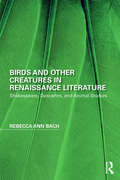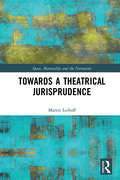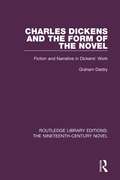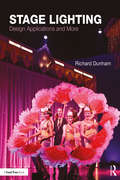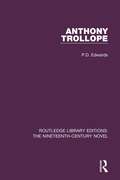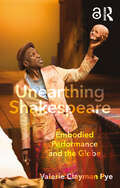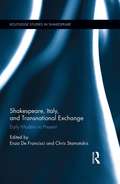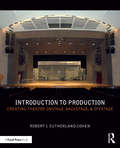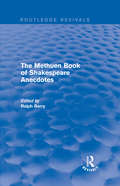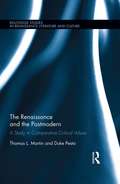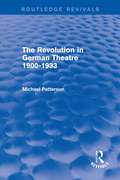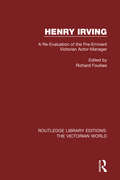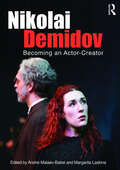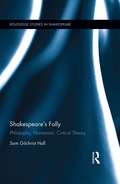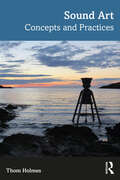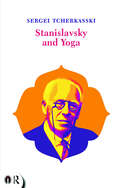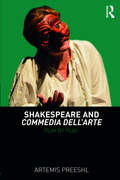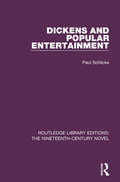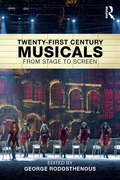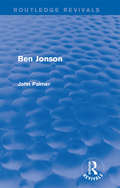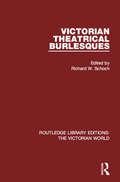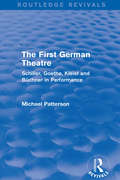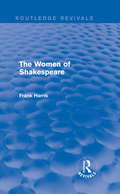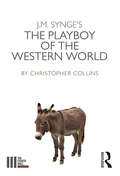- Table View
- List View
Birds and Other Creatures in Renaissance Literature: Shakespeare, Descartes, and Animal Studies (Perspectives on the Non-Human in Literature and Culture)
by Rebecca Ann BachThis book explores how humans in the Renaissance lived with, attended to, and considered the minds, feelings, and sociality of other creatures. It examines how Renaissance literature and natural history display an unequal creaturely world: all creatures were categorized hierarchically. However, post-Cartesian readings of Shakespeare and other Renaissance literature have misunderstood Renaissance hierarchical creaturely relations, including human relations. Using critical animal studies work and new materialist theory, Bach argues that attending closely to creatures and objects in texts by Shakespeare and other writers exposes this unequal world and the use and abuse of creatures, including people. The book also adds significantly to animal studies by showing how central bird sociality and voices were to Renaissance human culture, with many believing that birds were superior to some humans in song, caregiving, and companionship. Bach shows how Descartes, a central figure in the transition to modern ideas about creatures, lived isolated from humans and other creatures and denied ancient knowledge about other creatures’ minds, especially bird minds. As significantly, Bach shows how and why Descartes’ ideas appealed to human grandiosity. Asking how Renaissance categorizations of creatures differ so much from modern classifications, and why those modern classifications have shaped so much animal studies work, this book offers significant new readings of Shakespeare’s and other Renaissance texts. It will contribute to a range of fields, including Renaissance literature, history, animal studies, new materialism, and the environmental humanities.
Towards a Theatrical Jurisprudence
by Marett LeiboffThis book brings the insights of theatre theory to law, legal interpretation and the jurisprudential to reshape law as a practice of response and responsibility. Confronting a Baconian antitheatrical legality embedded in its jurisprudences and interpretative practices, Marett Leiboff turns to theatre theory and practice to ground a theatrical jurisprudence, taking its cues from Han-Thies Lehmann’s conception of the post-dramatic theatre and the early work of theatre visionary Jerzy Grotowski. She asks law to move beyond an imagined ideal grounded in Aristotelian drama and tragedy, and turns to the formation of the legal interpreter ・ lawyer, judge, jurisprudent ・ as fundamental to understanding what’s “noticed” or not noticed in law. We “notice” most easily through that which is written into the body of the legal interpreter, in a way that can’t be replicated through law’s standard practices of thinking and reasoning. Without more, thinking and reasoning are the epitome of antitheatricality legality; a set of theatrical antonyms, including transgression and instinct, offer instead a set of possibilities through which to reconceive assumptions and foundational concepts etched into the legal imaginary. And by turning to critical dramaturgy, the book reveals that the liveliness that sits behind theatrical jurisprudence isn’t a new concept in law at all, but has a long pedigree and lineage that had been lost and hidden. Theatrical jurisprudence, which demands an awareness of self and beyond self, grounds a responsiveness that can’t be found within doctrine, principle, or the technocratic, but also challenges us to notice what it is we think we know as well as what we know of lives in law that aren’t our own. The book will be of interest to scholars and students in the field of jurisprudence, legal theory, theatre and performance studies, cultural studies and philosophy.
Charles Dickens and the Form of the Novel: Fiction and Narrative in Dickens' Work (Routledge Library Editions: The Nineteenth-Century Novel #8)
by Graham DaldryFirst published in 1987. While there have been commentaries on his humour, his seriousness, his social concerns, and other specific aspects of his work such accounts have only tended to divide our understanding of the novels, to lead us to see them as failures of artistic unity. In this book the author seeks to address this question of unity and find a terminology that can treat language, plot and representation of reality as a coherent imaginative effort. This thesis is worked out in detail with reference to several of the novels, and represents a challenging re-evaluation Dickens’ achievement as a novelist. This book will be if interest to student of literature.
Stage Lighting: Design Applications and More
by Richard E DunhamStage Lighting: Design Applications and More builds upon the information introduced in Stage Lighting: The Fundamentals to provide an in-depth reference to a number of specialty areas of lighting design, from traditional applications such as drama, dance, and designing for different venues, to more advanced applications such as concert, corporate, film and video, virtual, architectural/landscape, and other forms of entertainment lighting. Each chapter gives the essential background, design practices, and equipment details for each specialization, so readers can make informed decisions and ask informed questions when encountering each field. The book provides insight on the latest technology and includes profiles of prolific designers, such as James Moody, Jeff Ravitz, Alan Adelman, and Paul Gregory. Stage Lighting: Design Applications and More is intended to help lighting designers translate their theatrical skills to other areas of lighting design, and provides guidance on how to take those initial steps into new ventures in their lighting careers.
Anthony Trollope: His Art And Scope (Routledge Library Editions: The Nineteenth-Century Novel #12)
by P.D. EdwardsFirst published in 1968, this book sets out to refute the idea of Trollope as a ‘mild cathedral-town novelist, describing storms in ecclesiastical tea cups’ which prevailed at the time in spite of his stature during his lifetime. The author reveals the full strength and range of Trollope’s achievement and provides an excellent introduction to further exploration of the novels. Two sections — ‘Narrative Method’ and ‘Subject-Matter’ — are used as the basis from which the author examines key themes in Trollope’s work, with instructive extracts from the novels included to illustrate these points and upon which commentary is provided. This book will be of interest to students of literature.
Unearthing Shakespeare: Embodied Performance and the Globe
by Valerie Clayman PyeWhat can the Globe Theatre tell us about performing Shakespeare? Unearthing Shakespeare is the first book to consider what the Globe, today’s replica of Shakespeare’s theatre, can contribute to a practical understanding of Shakespeare’s plays. Valerie Clayman Pye reconsiders the material evidence of Early Modern theatre-making, presenting clear, accessible discussions of historical theatre practice; stages and staging; and the relationship between actor and audience. She relays this into a series of training exercises for actors at all levels. From "Shakesball" and "Telescoping" to Elliptical Energy Training and The Radiating Box, this is a rich set of resources for anyone looking to tackle Shakespeare with authenticity and confidence.
Unearthing Shakespeare: Embodied Performance and the Globe
by Valerie Clayman PyeWhat can the Globe Theatre tell us about performing Shakespeare?Unearthing Shakespeare is the first book to consider what the Globe, today’s replica of Shakespeare’s theatre, can contribute to a practical understanding of Shakespeare’s plays. Valerie Clayman Pye reconsiders the material evidence of Early Modern theatre-making, presenting clear, accessible discussions of historical theatre practice; stages and staging; and the relationship between actor and audience. She relays this into a series of training exercises for actors at all levels. From "Shakesball" and "Telescoping" to Elliptical Energy Training and The Radiating Box, this is a rich set of resources for anyone looking to tackle Shakespeare with authenticity and confidence.
Shakespeare, Italy, and Transnational Exchange: Early Modern to Present (Routledge Studies in Shakespeare)
by Enza De Francisci Chris StamatakisThis interdisciplinary, transhistorical collection brings together international scholars from English literature, Italian studies, performance history, and comparative literature to offer new perspectives on the vibrant engagements between Shakespeare and Italian theatre, literary culture, and politics, from the sixteenth to the twenty-first century. Chapters address the intricate, two-way exchange between Shakespeare and Italy: how the artistic and intellectual culture of Renaissance Italy shaped Shakespeare’s drama in his own time, and how the afterlife of Shakespeare’s work and reputation in Italy since the eighteenth century has permeated Italian drama, poetry, opera, novels, and film. Responding to exciting recent scholarship on Shakespeare and Italy, as well as transnational theatre, this volume moves beyond conventional source study and familiar questions about influence, location, and adaptation to propose instead a new, evolving paradigm of cultural interchange. Essays in this volume, ranging in methodology from archival research to repertory study, are unified by an interest in how Shakespeare’s works represent and enact exchanges across the linguistic, cultural, and political boundaries separating England and Italy. Arranged chronologically, chapters address historically-contingent cultural negotiations: from networks, intertextual dialogues, and exchanges of ideas and people in the early modern period to questions of authenticity and formations of Italian cultural and national identity in the eighteenth and nineteenth century. They also explore problems of originality and ownership in twentieth- and twenty-first-century translations of Shakespeare’s works, and new settings and new media in highly personalized revisions that often make a paradoxical return to earlier origins. This book captures, defines, and explains these lively, shifting currents of cultural interchange.
Introduction to Production: Creating Theatre Onstage, Backstage, & Offstage
by Robert I. Sutherland-CohenIntroduction to Production: Creating Theatre Onstage, Backstage, & Offstage defines the collaborative art of making theatre and the various job positions that go into realizing a production. Beginning with an overview of the art and industry of theatre, the book shows how theatre has evolved through history. The book then breaks down the nuts and bolts of the industry by looking at each professional role within it: from the topmost position of the producer down to the gopher, or production assistant. Each of these positions are defined along with their respective duties, rules, and resources that figure in obtaining these jobs. Each chapter offers exercises, links to videos and websites, review quizzes, and suggested readings to learn more about the creation and production of theatre.
The Methuen Book of Shakespeare Anecdotes
by Ralph BerryFew playwrights have been more slandered, abused or honoured in performance than William Shakespeare. First published in 1992, this collection of 300 stories focuses on Shakespeare’s plays on stage. Organised chronologically, it offers the reader the opportunity to witness the changes in theatrical approaches to Shakespeare from their own time to the present day. This book will be of interest to those studying theatre, but also to those fascinated by the Shakespeare tradition.
The Renaissance and the Postmodern: A Study in Comparative Critical Values (Routledge Studies in Renaissance Literature and Culture)
by Thomas L Martin Duke PestaThe Renaissance and the Postmodern reconsiders postmodern readings of Renaissance texts by engaging in a dialectics the authors call comparative critical values. Rather than concede the contemporary hierarchy of theory over literature, the book takes the novel approach of consulting major Renaissance writers about the values at work in postmodern representations of early modern culture. As criticism seeks new directions and takes new forms, insufficient attention has been paid to the literary and philosophical values won and lost in the exchanges. One result is that the way we understand the logical connections, the literary textures, and the philosophical impulses that make up the literature of writers like Spenser, Shakespeare, and Milton has fundamentally changed. Examining theoretical debates now in light of polemical controversies then, the book goes beyond earlier studies in that it systematically examines the effects of these newer critical approaches across their materialist, historicist, deconstructive, and psychoanalytic manifestations. Bringing gravity and focus to this question of critical continuities and discontinuities, each chapter counterposes one major Renaissance voice with a postmodern one to probe these issues and with them the value of the cultural past. As voices on both sides of the historical divide illuminate key differences between the Renaissance and the Postmodern, a critical model emerges from the book to re-engage this period’s humane literature in a contemporary context with intellectual rigor and a renewed sense of cultural enrichment.
The Revolution in German Theatre 1900-1933 (Routledge Revivals)
by Michael PattersonFirst published in 1981, this book represents the first work in English to give a comprehensive account of the revolutionary developments in German theatre from the decline of Naturalism through the Expressionist upheaval to the political theatre of Piscator and Brecht. Early productions of Kaiser’s From Morning till Midnight and Toller’s Transfiguration are presented as examples of Expressionism. A thorough analysis of Piscator’s Hoppla, Such is Life! And Brecht’s Man show the similarities and differences in political theatre. In addition, elements of stage-craft are examined — illustrated with tabulated information, an extensive chronology, and photographs and designs of productions.
Henry Irving: A Re-Evaluation of the Pre-Eminent Victorian Actor-Manager (Routledge Library Editions: The Victorian World #18)
by Richard FoulkesHenry Irving (1838-1905), the first actor to be knighted, dominated the theatre in Britain and beyond for over a quarter of a century. As an actor, he was strikingly different with his idiosyncratic pronunciation, his somewhat ungainly physique, and his brilliant psychological portrayals of virtue and villainy. He was also the director of spectacular, and commercially driven, entertainments and as the manager of the Lyceum theatre, he controlled every aspect of the performance. First published in 2008, this collection of essays by leading theatre scholars explores each element of Irving’s art: his acting, his contribution to the plays he commissioned, his flair for the stage picture, and his ear for incidental music. This book will be of interest to those studying the history of theatre.
Nikolai Demidov
by Nikolai DemidovAt the time of his death, Stanislavsky considered Nikolai Demidov to be ‘his only student, who understands the System’. Demidov’s incredibly forward-thinking processes not only continued his teacher’s pioneering work, but also solved the problems of an actor’s creativity that Stanislavsky never conquered. This book brings together Demidov’s five volumes on actor training. Supplementary materials, including transcriptions of Demidov’s classes, and notes and correspondence from the author make this the definitive collection on one of Russian theatre’s most important figures.
Shakespeare's Folly: Philosophy, Humanism, Critical Theory (Routledge Studies in Shakespeare)
by Sam HallThis study contends that folly is of fundamental importance to the implicit philosophical vision of Shakespeare’s drama. The discourse of folly’s wordplay, jubilant ironies, and vertiginous paradoxes furnish Shakespeare with a way of understanding that lays bare the hypocrisies and absurdities of the serious world. Like Erasmus, More, and Montaigne before him, Shakespeare employs folly as a mode of understanding that does not arrogantly insist upon the veracity of its own claims – a fool’s truth, after all, is spoken by a fool. Yet, as this study demonstrates, Shakespearean folly is not the sole preserve of professional jesters and garrulous clowns, for it is also apparent on a thematic, conceptual, and formal level in virtually all of his plays. Examining canonical histories, comedies, and tragedies, this study is the first to either contextualize Shakespearean folly within European humanist thought, or to argue that Shakespeare’s philosophy of folly is part of a subterranean strand of Western philosophy, which itself reflects upon the folly of the wise. This strand runs from the philosopher-fool Socrates through to Montaigne and on to Nietzsche, but finds its most sustained expression in the Critical Theory of the mid to late twentieth-century, when the self-destructive potential latent in rationality became an historical reality. This book makes a substantial contribution to the fields of Shakespeare, Renaissance humanism, Critical Theory, and Literature and Philosophy. It illustrates, moreover, how rediscovering the philosophical potential of folly may enable us to resist the growing dominance of instrumental thought in the cultural sphere.
Sound Art: Concepts and Practices
by Thom HolmesSound Art offers the first comprehensive introduction to sound art written for undergraduate students. Bridging and blending aspects of the visual and sonic arts, modern sound art first emerged in the early 20th century and has grown into a thriving and varied field. In 13 thematic chapters, this book enables students to clearly grasp both the concepts behind this unique area of art, and its history and practice. Each chapter begins with an exploration of key ideas and theories, followed by an in-depth discussion of selected relevant works, both classic and current. Drawing on a broad, diverse range of examples, and firmly interdisciplinary, this book will be essential reading for anyone studying or teaching the theory, history, appreciation, or practice of sound art.
Stanislavsky and Yoga (Routledge Icarus)
by Sergei TcherkasskiThis book deals with one of the most important sources of the Stanislavsky System - Yoga, its practice and philosophy. Sergei Tcherkasski carefully collects records on Yoga in Stanislavsky's writings from different periods and discusses hidden references which are not explained by Stanislavsky himself due to the censorship in his day. Vivid examples of Yoga based training from the rehearsal practice of the Moscow Art Theatre and many of Stanislavsky's studios (the First Studio in 1910s, the Second Studio and Opera Studio of the Bolshoi Theatre in 1920s, Opera-Dramatic Studio in 1930s) are provided. The focus of Tcherkasski's research consists of a comparative reading of the Stanislavsky System and Yogi Ramacharaka's books, which were a main source for Stanislavsky. Accordingly, Tcherkasski analyzes elements of the System based on Yoga principles. Among them are: relaxation of muscles (muscular release), communication and prana, emission of rays and reception of rays, beaming of aura, sending of prana, attention, visualizations (mental images). Special attention is paid to the idea of the superconscious in Yoga, and in Ramacharaka's and Stanislavsky's theories. Tcherkasski's wide-ranging analysis has resulted in new and intriguing discoveries about the Russian master. Furthermore, he reveals the extent to which Stanislavsky anticipated modern discoveries in neurobiology and cognitive science. In this book Tcherkasski acts as a researcher, historian, theatre director, and experienced acting teacher. He argues that some forty per cent of basic exercises in any Stanislavsky based actor training program of today are rooted in Yoga. Actors, teachers, and students will find it interesting to discover that they are following in the footsteps of Yoga in their everyday Stanislavsky based training and rehearsals.
Shakespeare and Commedia dell'Arte: Play by Play
by Artemis PreeshlShakespeare and Commedia dell’Arte examines the ongoing influence of commedia dell’arte on Shakespeare’s plays. Exploring the influence of commedia dell’arte improvisation, sight gags, and wordplay on the development of Shakespeare’s plays, Artemis Preeshl blends historical research with extensive practical experience to demonstrate how these techniques might be applied when producing some of Shakespeare's best-known works today. Each chapter focuses on a specific play, from A Midsummer Night’s Dream to The Winter’s Tale, drawing out elements of commedia dell’arte style in the playscripts and in contemporary performance. Including contemporary directors’ notes and interviews with actors and audience members alongside Elizabethan reviews, criticism, and commentary, Shakespeare and Commedia dell’Arte presents an invaluable resource for scholars and students of Renaissance theatre.
Dickens and Popular Entertainment (Routledge Library Editions: The Nineteenth-Century Novel #34)
by Paul SchlickeFirst published in 1985. Dickens was a vigorous champion of the right of all men and women to carefree amusements and dedicated himself to the creation of imaginative pleasure. This book represents the first extended study of this vital aspect of Dickens’ life and work, exploring how he channelled his love of entertainment into his artistry. This study offers a challenging reassessment of Nicholas Nickleby, The Old Curiosity Shop and Hard Times. It shows the importance of entertainment to Dickens’ journalism and presents an illuminating perspective on the public readings which dominated the last twelve years of his life. This book will be of interest to students of literature.
Twenty-First Century Musicals: From Stage to Screen
by George RodosthenousTwenty-First Century Musicals stakes a place for the musical in today’s cinematic landscape, taking a look at leading contemporary shows from their stage origins to their big-screen adaptations. Each chapter offers a new perspective on a single musical, challenging populist narratives and exploring underlying narratives and sub-texts in depth. Themes of national identity; race, class and gender; the ‘voice’ and ‘singing live’ on film; authenticity; camp sensibilities; and the celebration of failure are addressed in a series of questions including: How does the film adaptation provide a different viewing experience from the stage version? What themes are highlighted in the film adaptation? What does the new casting bring to the work? Do camera angles dictate a different reading from the stage version? What is lost/gained in the process of adaptation to film? Re-interpreting the contemporary film musical as a compelling art form, Twenty-First Century Musicals is a must-read for any student or scholar keen to broaden their understanding of musical performance.
Ben Jonson (Routledge Revivals)
by John PalmerOriginally published in 1934, Palmer’s biography of famous playwright Ben Jonson delves into his life and works and what he achieved in both. As first poet laureate of England, Jonson’s life presents a fascinating look into the state of literature and theatre in renaissance Britain which Palmer presents in great detail. This title will be of interest to students of literature.
Victorian Theatrical Burlesques (Routledge Library Editions: The Victorian World)
by Richard W. SchochFirst published in 2003. Wildly popular in their own day, Victorian burlesques are now little read, scarcely studied, and never performed. Giving long overdue emphasis to an unjustly neglected theatrical tradition, this critical edition - the first to focus on Victorian burlesques of Victorian plays - represents a valuable scholarly tool for students and scholars of modern drama, theatre history, and nineteenth-century popular culture. Victorian Theatrical Burlesques includes a 'state-of-the-art' introduction which provides a general overview of theatrical burlesques in the Victorian era, emphasising performance history. Sustained reference is made to burlesques other than those presented in the anthology. Through its general introduction, prefaces and annotations to individual plays, checklist of burlesque plays, and bibliography, the unique volume allows both specialist and non-specialist readers to see Victorian burlesques as a rich historical record of shifting attitudes toward drama and the theatre.
The First German Theatre (Routledge Revivals): Schiller, Goethe, Kleist and Büchner in Performance
by Michael PattersonFirst published in 1990. The book surveys of the development of German theatre from a market sideshow into an important element of cultural life and political expression. It examines Schiller as ‘theatre poet’ at Mannheim, Goethe’s work as director of the court theatre at Weimar, and then traces the rapid commercial decline that made it difficult for Kleist and impossible for Büchner to see their plays staged in their own lifetime. Four representative texts are analysed: Schiller’s The Robbers, Goethe’s Iphigenia on Tauris, Kleist’s The Prince of Homburg, and Büchner’s Woyzeck. This title will be of interest to students of theatre and German literature.
The Women of Shakespeare (Routledge Revivals)
by Frank HarrisFrank Harris argues that the way women are presented in Shakespeare’s plays and sonnets are a reflection of the real-life women in his life, namely his wife, mother, mistress and daughter. Originally published in 1911, The Women of Shakespeare also analyses the traditional criticism of the time and places his own views in this context. This title will be of interest to students of English Literature.
The Playboy of the Western World (The Fourth Wall)
by Christopher Collins‘I’m thinking this night wasn’t I a foolish fellow not to kill my father in years gone by.’ – Christy Mahon On the first night of J. M. Synge’s The Playboy of the Western World (1907) the audience began protesting in the theatre; by the third night the protests had spilled onto the streets of Dublin. How did one play provoke this? Christopher Collins addresses The Playboy ’s satirical treatment of illusion and realism in light of Ireland’s struggle for independence, as well as Synge’s struggle for artistic expression. By exploring Synge’s unpublished diaries, drafts and notebooks, he seeks to understand how and why the play came to be. This volume invites the reader behind the scenes of this inflammatory play and its first performances, to understand how and why Synge risked everything in the name of art.
